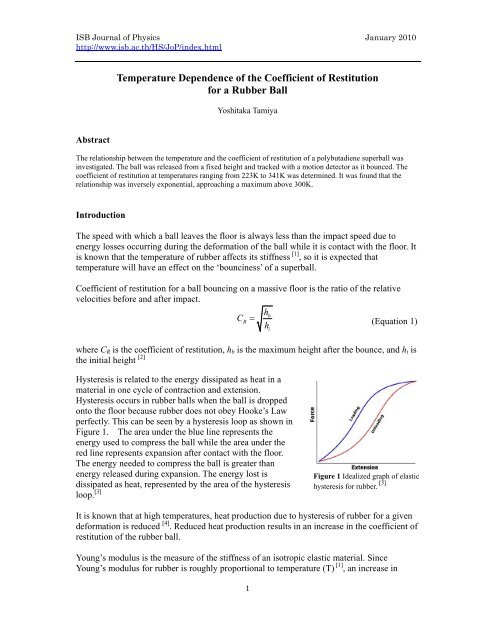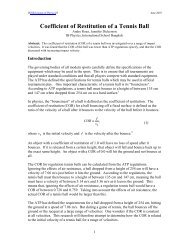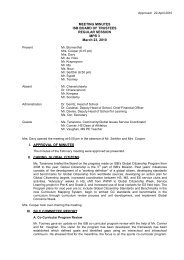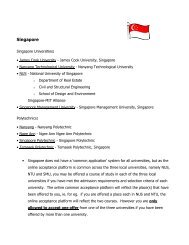Temperature Dependence of the Coefficient of Restitution for a ...
Temperature Dependence of the Coefficient of Restitution for a ...
Temperature Dependence of the Coefficient of Restitution for a ...
You also want an ePaper? Increase the reach of your titles
YUMPU automatically turns print PDFs into web optimized ePapers that Google loves.
ISB Journal <strong>of</strong> Physics January 2010http://www.isb.ac.th/HS/JoP/index.html<strong>Temperature</strong> <strong>Dependence</strong> <strong>of</strong> <strong>the</strong> <strong>Coefficient</strong> <strong>of</strong> <strong>Restitution</strong><strong>for</strong> a Rubber BallYoshitaka TamiyaAbstractThe relationship between <strong>the</strong> temperature and <strong>the</strong> coefficient <strong>of</strong> restitution <strong>of</strong> a polybutadiene superball wasinvestigated. The ball was released from a fixed height and tracked with a motion detector as it bounced. Thecoefficient <strong>of</strong> restitution at temperatures ranging from 223K to 341K was determined. It was found that <strong>the</strong>relationship was inversely exponential, approaching a maximum above 300K.IntroductionThe speed with which a ball leaves <strong>the</strong> floor is always less than <strong>the</strong> impact speed due toenergy losses occurring during <strong>the</strong> de<strong>for</strong>mation <strong>of</strong> <strong>the</strong> ball while it is contact with <strong>the</strong> floor. Itis known that <strong>the</strong> temperature <strong>of</strong> rubber affects its stiffness [1] , so it is expected thattemperature will have an effect on <strong>the</strong> ‘bounciness’ <strong>of</strong> a superball.<strong>Coefficient</strong> <strong>of</strong> restitution <strong>for</strong> a ball bouncing on a massive floor is <strong>the</strong> ratio <strong>of</strong> <strong>the</strong> relativevelocities be<strong>for</strong>e and after impact.hbCRh(Equation 1)where C R is <strong>the</strong> coefficient <strong>of</strong> restitution, h b is <strong>the</strong> maximum height after <strong>the</strong> bounce, and h i is<strong>the</strong> initial height [2]iHysteresis is related to <strong>the</strong> energy dissipated as heat in amaterial in one cycle <strong>of</strong> contraction and extension.Hysteresis occurs in rubber balls when <strong>the</strong> ball is droppedonto <strong>the</strong> floor because rubber does not obey Hooke’s Lawperfectly. This can be seen by a hysteresis loop as shown inFigure 1. The area under <strong>the</strong> blue line represents <strong>the</strong>energy used to compress <strong>the</strong> ball while <strong>the</strong> area under <strong>the</strong>red line represents expansion after contact with <strong>the</strong> floor.The energy needed to compress <strong>the</strong> ball is greater thanenergy released during expansion. The energy lost isdissipated as heat, represented by <strong>the</strong> area <strong>of</strong> <strong>the</strong> hysteresisloop. [3]Figure 1 Idealized graph <strong>of</strong> elastichysteresis <strong>for</strong> rubber. [3]It is known that at high temperatures, heat production due to hysteresis <strong>of</strong> rubber <strong>for</strong> a givende<strong>for</strong>mation is reduced [4] . Reduced heat production results in an increase in <strong>the</strong> coefficient <strong>of</strong>restitution <strong>of</strong> <strong>the</strong> rubber ball.Young’s modulus is <strong>the</strong> measure <strong>of</strong> <strong>the</strong> stiffness <strong>of</strong> an isotropic elastic material. SinceYoung’s modulus <strong>for</strong> rubber is roughly proportional to temperature (T) [1] , an increase in1
ISB Journal <strong>of</strong> Physics January 2010temperature <strong>of</strong> <strong>the</strong> rubber will result in an increase in Young’s modulus, or in o<strong>the</strong>r words, adecrease in <strong>the</strong> compression distance <strong>of</strong> <strong>the</strong> ball. Less energy will be dissipated in eachbounce, leading to an increase in <strong>the</strong> coefficient <strong>of</strong> restitution.Given <strong>the</strong>se two known relationships, <strong>the</strong> coefficient <strong>of</strong> restitution is expected to increase as<strong>the</strong> temperature increases.MethodsThe polybutadiene superball used,Figure 2, had a diameter <strong>of</strong> 4.8 ±0.1cm, and a mass <strong>of</strong> 52.51 ± 0.01 g.The ball was released from a height <strong>of</strong>0.860 ± 0.003 m beneath a fixedmotion detector, as shown in Figure 3.A thread was attached to <strong>the</strong> ball, and<strong>the</strong> ball held by this to reduce any spinupon release.Figure 2 The rubberball used.Figure 3 Illustration <strong>of</strong> <strong>the</strong> set-up.The position <strong>of</strong> <strong>the</strong> ball was tracked as it felland bounced on a hard, linoleum-coveredconcrete floor, as shown in figure 4. Thecoefficient <strong>of</strong> restitution was determined fromthis data.The temperature <strong>of</strong> <strong>the</strong> ball was changed bysubmerging it in a liquid bath <strong>for</strong> 10 minutesbe<strong>for</strong>e each set <strong>of</strong> trials. A dry ice and ethanolbath was used <strong>for</strong> <strong>the</strong> low temperatures and awater bath was used <strong>for</strong> high temperatures.<strong>Temperature</strong>s tested ranged from 223K to341K, with three trials taken at eachtemperature.Figure 4 The height <strong>of</strong> <strong>the</strong> ball after one bounce wasdetermined. The position represents <strong>the</strong> distancefrom <strong>the</strong> motion detector to <strong>the</strong> top <strong>of</strong> <strong>the</strong> ball.Results and DiscussionFrom figure 5, <strong>the</strong> relationship between temperature <strong>of</strong> <strong>the</strong> ball and <strong>the</strong> coefficient <strong>of</strong>restitution is given by <strong>the</strong> equation R 6000 . 0.90 (Equation 2)There is an inverse exponential relationship between <strong>the</strong> temperature and <strong>the</strong> coefficient <strong>of</strong>restitution.The coefficient approaches a maximum value <strong>of</strong> 0.90. Even when <strong>the</strong> ball is at hightemperatures, some <strong>of</strong> <strong>the</strong> mechanical energy <strong>of</strong> <strong>the</strong> ball will be lost during each bounce.Hysteresis is less significant at higher temperatures but does not fully disappear.2
ISB Journal <strong>of</strong> Physics January 2010The minimum coefficient <strong>of</strong>restitution found during thisexperiment was around 0.56, at223K, as this was <strong>the</strong> coldest ourethanol bath could reach. Giventhat only one temperaturebetween 200 K and 250 K wastested, <strong>the</strong>re is little confidencein equation 2 at temperaturesbelow 250 K. Fur<strong>the</strong>r tests couldbe conducted at temperaturesbetween 200K and 250 K.The relationship between <strong>the</strong>coefficient <strong>of</strong> restitution andtemperature <strong>for</strong> situations using adifferent ball or surface isFigure 5 The temperature <strong>of</strong> <strong>the</strong> rubber ball is plotted against <strong>the</strong>coefficient <strong>of</strong> restitution. An inverse exponential relationship isshown.expected to result in a similar inverse exponential relationship, with different maximumcoefficients at high temperatures. This is expected since all rubber materials exhibithysteresis.ConclusionThere is an inverse exponential relationship between <strong>the</strong> temperature <strong>of</strong> <strong>the</strong> polybutadienesuperball bouncing on a linoleum covered concrete floor and <strong>the</strong> coefficient <strong>of</strong> restitution.The coefficient approaches a maximum <strong>of</strong> 0.90, at temperatures above 300 K.References[1] Yoshioka, Daijiro. "The Elasticity <strong>of</strong> Rubber." Statistical Physics. N.p.: Springer BerlinHeidelberg, 2007. 83-87. SpringerLink. Web. November 27, 2009.http://www.springerlink.com/content/mq10r2625154226m/[2] <strong>Coefficient</strong> <strong>of</strong> <strong>Restitution</strong>. Retrieved November 15, 2009, from Wikipedia:http://en.wikipedia.org/wiki/<strong>Coefficient</strong>_<strong>of</strong>_restitution[3] Hysteresis. Retrieved January 25, 2010, from Wikipedia:http://en.wikipedia.org/wiki/Hysteresis[4] Donnet, Jean-Baptiste, Roop Chand Bansal, and Meng-Jiao Wang. "Energy Dissipation.”Carbon Black: Science and Technology . 359. Google Books. CRC Press, 1993.Retreived January 20, 2010. http://books.google.co.th/books3
















